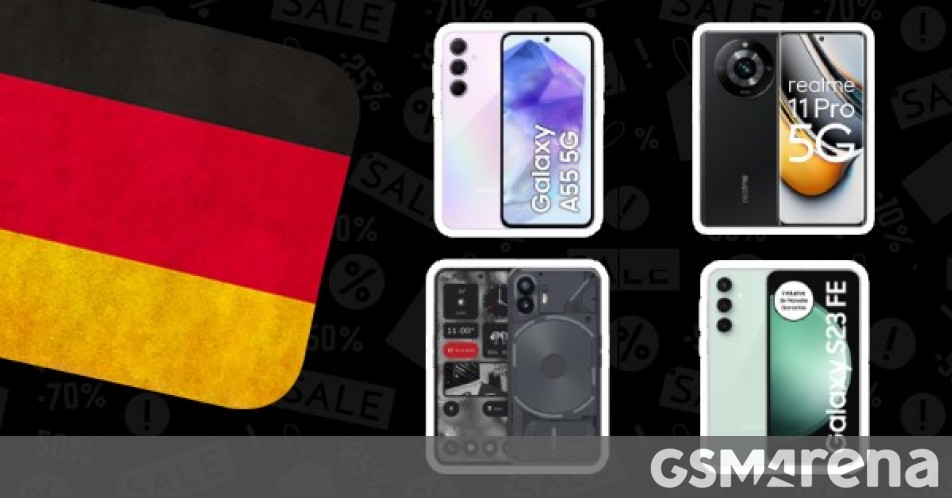The Galaxy A55 is a solid mid-ranger, though it is on the pricey side. It’s too early for discounts, but Samsung does offer a launch promotion – a free storage upgrade. This means that the 256GB model costs the same as the 128GB one.
Also, you get an €80 trade-in bonus over the value of the old phone that you send in. For example, a Galaxy A54 is valued at €200 (for a 128GB unit). With that and the bonus, the A55 256GB drops to €200. The older A53 (128GB) could fetch €170, while an A52 (128GB) would get you €140. Note that if the phone you’re trading in has 256GB storage instead, you can get €20-30 more.
In places like the UK, the A55 costs the same as the Samsung Galaxy S23 FE and that’s not a great deal. In the US, the A55 isn’t even available – “buy the S23 FE,” says Samsung.
In Germany, the situation is a bit different. Samsung.com sells the 8/128GB Galaxy S23 FE at €630, Amazon has it a bit cheaper at €605. Both are noticeably pricier than the A55, before you even take in the promo offer into account.
The A55 may have the slower chipset (Exynos 2200 on the FE), but it offers much better battery life (13:27h active use score vs. 8:28h). And you’re getting an aluminum frame and Victus+ on the front with the new A-phone. Besides the chipset, the only place where the A55 falls short is zoom – it has no answer to S23 FE’s 8MP 3x camera.
Anyway, the Galaxy A35 has a free storage upgrade too and here it is even more relevant as the 128GB model has 6GB of RAM, while the 256GB one has 8GB. There is a microSD slot, of course, so you can always add more storage, but you can’t add more RAM. As for the phone itself, it’s similar to the A54 from last year.
Compared to the A55, it is more plasticy (both the chassis and the back, the front is still Victus+) and you get the older but still decent Exynos 1380. There are a few other changes (e.g. 13MP selfie camera instead of 32MP) too.
The Nothing Phone (2) is slowly falling in price and a 12/256GB unit can be yours for under €550 – that’s less than the Galaxy S23 FE. The Snapdragon 8+ Gen 1 is more efficient than the Exynos 2200 and you get an LTPO display – 6.7” 120Hz with FHD+ resolution and 10-bit colors.
Plus a 50MP ultra wide instead of 12MP, but no tele camera. Also, the dust and water resistance is a basic IP54, but it should be good enough for most cases. The 4,700mAh battery supports both 45W wired and 15W wireless charging, but the battery endurance is miles ahead (14:21h active use score vs. 8:28h).
The Realme 11 Pro may look upscale with its curved display, but it is a mid-ranger at heart. And now that it costs €240, it offers great value for money. It combines a 6.7” 120Hz FHD+ display (10-bit colors) with a Dimensity 7050 for decent performance and 5G connectivity. It has a 100MP main camera with OIS with pretty good 2x in-sensor zoom (there’s no ultra wide, though). Battery endurance is solid (13:14h active use score) and the 5,000mAh battery is fully charged in 47 minutes.
For around the same amount of cash you can get the Redmi Note 13 instead. It has a comparable display and both a 108MP main camera and an 8MP ultra wide. The 2x in-sensor zoom wasn’t great, but the 3x option is pretty solid (a consequence of the Nonapixel array on the ISOCELL HM6).
There’s no OIS on the main camera, though and the battery is worse – the same 5,000mAh capacity only earned a 9:49 active use score. The 33W charging is predictably slower and needs 76 minutes for a full charge. Finally, the Dimensity 6080 chipset in the Redmi is just slower than the 7050 in the Realme.
Have you ever wanted to try VR but were worried that it would be a big investment? The Meta Quest 2 is down to €250, so now may be the time to give it a shot. The Quest 3 improves the resolution and adds color passthrough, but it costs more than double, so it’s harder to recommend for first-timers.
We may get a commission from qualifying sales.

